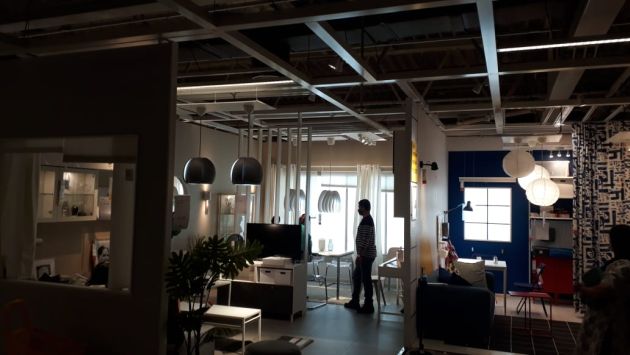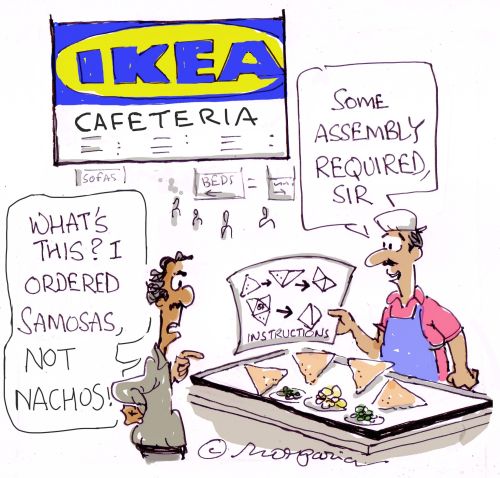I’ve visited several IKEA stores outside India during the past 20+ years.
While I haven’t been able to visit the furniture retailer’s first Indian store that opened in Hyderabad four years ago, I got a chance to visit its new store in Mumbai recently.
This store is as big as any of the other IKEA stores I’ve been to. Like all the others, it follows the so-called Gruen Transfer shop layout whereby, once you enter it, you must pass through the entire store before you can exit.
It’s too early for me to comment about the quality of the goods at this store but I’m sure everything will last 4-5 years. That’s good enough for modern day consumers who tend to change the furniture and fittings in their homes once in 3-5 years.
According to the Economic Times, IKEA plans to slash its prices to attract more customers in India.
I’m guessing that the company’s strategy is based on the popular narrative that Indians are very price sensitive.
IMO, that’s a misconception. As I’ve pointed out on several occasions, Indians are more deal-sensitive than price-sensitive.
The prices at the store are quite attractive as they are. I don’t think there’s any need to lower them.
On the other hand, the shopping experience at this store sucks and there’s ample scope to improve it by trying out the following things.
 Make it easy to shop. The world’s largest furniture retailer asks customers to “note down” the product details on a piece of paper and take it to checkout or install an app for instore shopping.
Make it easy to shop. The world’s largest furniture retailer asks customers to “note down” the product details on a piece of paper and take it to checkout or install an app for instore shopping.
Hardly anybody uses paper and pen these days. I doubt if people who shop on apps will bother to visit a physical store in the first place.
Both options seem daft.
(That said, it’s still easier to shop at this IKEA store than at the one in Frankfurt, where you to need to pick up the products from the shelves, load them up into a huge trolley, wheel it down four storeys to checkout and further to the parking lot.)
Revamp product descriptions. Product descriptions are literally translated from Swedish* (or is it Dutch?) and make no sense in English e.g. “bed frame”*. (For the uninitiated, IKEA originated in Sweden, is headquartered in the Netherlands and most of its products are Made in China.)
Be transparent about the scope of supply. Many products – e.g. modular kitchen – comprise a long list of components. Because the list is ambiguous, it’s very hard to figure out what’s included in the base price and what is not.
Shout that assembly is available. When IKEA opened its first Indian store in Hyderabad in 2018, I wrote in IKEA Will Die If It Expects Indians To DIY that the furniture retailer should not rely its classical DIY model in India. At the time, I predicted that
IKEA will either tweak its DIY model so suit Indian consumer behavior, as it has done in the Middle East by offering delivery and assembly service at a nominal cost at its Dubai store from the mid 1990s. Or it will stick to its DIY model to drive stickiness, as it has done in Europe and the USA. For its own sake, I hope the company chooses the first option in India because IKEA will die before Indians will DIY.
I’d like to think that somebody at IKEA read my post since the company has chosen the first option. I saw a sign at the entrance of the store that said “assembly available at extra cost”. But that solitary sign is not enough. The company should plaster this message all over the store.
Open downtown store. The Mumbai store is technically in Navi Mumbai, which is very remote – and infra dig – for most shoppers from South Bombay and Western suburbs. It took me 45 minutes to get a Uber to go back home from the store. I think IKEA has realized that point even though it’s too late for it to do anything about the location of the current store. The retailer’s plan to open a new store in Kamala Mills Compound in Parel in the city center is a step in the right direction.
Nobody is going to complain if IKEA slashes prices but the smart move on the part of the world’s largest furniture retailer would to be fix the above issues on priority.
One quick fix is to add more salespersons at the aisle.
I was there in the store for about two hours. During that entire duration, I couldn’t spot a single salesperson. It reminded me of Germany, France and other countries in Europe where it was hard to find sales people in supermarkets, department stores and other retail outlets.
The shopping preferences of the Indian consumer are notoriously difficult to predict but I’ll go out on a limb and assert that Indians who visit a brick-and-mortar store will not buy something costing INR 4.5 lakhs (US$ 6000) – the median price of modular kitchen at this store – without talking to a human.
IKEA should deploy more salespersons at the aisle to answer questions about the product, price, inclusions versus exclusions, and availability of assembly, and to finally take the order. That will fix virtually all of the abovementioned shortcomings in the store.
Near the checkout, I saw a sign saying IKEA saves money by having fewer staff and passes on the savings to customers by way of lower prices. My $0.02: The company should hold its price steady and spend the intended price reductions on salespersons.
If it does that, I’m quite sure that IKEA will improve the shopping experience and manage to acquire more customers at the current price levels.
Per contra, if the company ignores the above issues, I’m very sure that it will not be able to win more customers in India even after slashing its prices.
Ikea is upping its prices by 9% (on average) due to continued supply-chain issues.
(Yet there will be no additional pains with regards to assembly, which is only less painful to walking on Legos)
PS that “Swedish furniture” is made in China.
— B Clagett (@Clagett) January 3, 2022
Unlike other furniture showrooms, all IKEA stores I’ve visited have restaurants.
The one in Navi Mumbai is no exception.
But what caught my attention about this restaurant was its size – it’s bigger than any standalone restaurant I’ve seen.
Ergo I was not surprised to read a few days later that this is one of the biggest restaurants in the retailer’s stores in Asia. It’s definitely the biggest instore restaurant at any IKEA store that I’ve visited. (Unfortunately, I forgot to click a pic.)
While the assortment was limited, the prices of food and drinks were very reasonable.
According to @UberFacts, it’s IKEA’s policy to have the absolute lowest price on a food item within a 30-mile radius, even if it means selling at a loss. So if they take a hit on some food, they hope to make it up in furniture.
Contrary to the predictions made when the Hyderabad store opened, I didn’t find any evidence that the restaurant followed the furniture retailer’s DIY ethos*!
* UPDATE DATED 6 JUNE 2022
A friend from USA who would like to stay anonymous weighed in on this post.
Please see the following email trail between us for more details.
FRIEND TO ME:
Great write up. I agree that most of Ikea’s product names are unintelligible and deliberately fake Swedish sounding. Their assembly instructions are literaly hieroglyphics – so they get away from having to print them in 20 languages globally. And their product descriptions are strange.
But why is “bed frame” unintelligible in Indian English?
ME TO FRIEND:
TY for your kind words.
In South India, we called it COT. When I moved to Bombay in my eighth standard, nobody understood what Cot meant and I was told it’s called BED in Bombay. When we say “sleep on the BED”, BED includes MATTRESS. But, when stores say BED, they exclude MATTRESS.
https://www.hometown.in/furniture/bedroom-furniture/beds
https://www.wakefit.co/bed/sheesham-wood-bed-phoenix/WSWB7872PHOENIX
While there’s ambiguity about the scope of BED, to this day, I haven’t heard the term BED FRAME used in India, hence it’s unintelligible to me.
FRIEND:
Interesting meanings for words. I guess “bed frame” is used here to disambiguate between a bed without a mattress from one with a mattress.
To make things complicated, most “mattresses” (or more precisely “mattress sets”) in the US are comprised of two pieces: a lower “box spring” which is literally that, a box with spring coils (wrapped in a fabric top), and an upper “mattress”. So if you want to purchase a mattress you are only looking for the latter. Both box spring and mattress are far thicker (vertically) than anything I had commonly seen in India.
Cot vs. Bed – What’s the difference? | Ask Difference
ME:
Quite likely.
Since Indians, by nature, lean towards ambiguity and don’t seek crystal clarity in anything, I’m guessing the term “bed frame” is not a thing in India.
I’ve come across the separation of mattress and box spring in Germany. Germans, by nature, lean towards complication. Even buying a bulb used to be a challenge, what with screw type v. pin type and many other specs for a simple bulb. Didn’t think complication was a thing in USA, at least in a B2C / retail context!
I didn’t know there were so many differences between Cot and Bed:).

